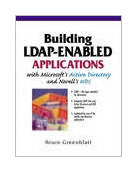|
||
• wydawnictwa polskie
• Zamów informacje o nowościach z wybranego tematu • kontakt
• Cookies na stronie |
BUILDING LDAP-ENABLED APPLICATIONS WITH MICROSOFT ACTIVE DIRECTORY&NDSGREENBLATT BRUCEwydawnictwo: PRENTICE HALL PTR , rok wydania 2002, wydanie Icena netto: Building LDAP-Enabled Applications with Microsoft's Active Directory and Novell Directory Service shows how to build LDAP-savvy applications in Active Directory and NDS. LDAP is an open, vendor-neutral standard for accessing directory information. The book uses real-world code examples to demonstrate how to access LDAP-enabled applications using Java servlets, Java applets, and Active Server Pages, and covers security issues. The only applied guide for LDAP development in Active Directory and NDS environments.
Lightweight Directory Access Protocol (LDAP) is an open, vendor-neutral standard for accessing directory information. Using LDAP, developers can transform directories built in Active Directory and Novell Directory Services (NDS) into extendable, multiplatform, Internet-enabled solutions. In this book, Bruce Greenblatt-one of the world's leading directory experts-shows exactly how to develop custom LDAP solutions in both Active Directory and NDS environments. With examples in Java, and with the near-universal access afforded by LDAP, this book provides the tools you need to make your distributed applications more widely available than ever before. Greenblatt begins with a discussion of LDAP and how it fits in with Internet standards, then explains LDAP schema design and security concepts. After detailed coverage of LDAP implementations in Active Directory and NDS, and an overview of how to use LDAP with Java, Greenblatt gives a first-hand look at Internet directories in action and walks through three complete application case studies-storage management, e-commerce, and a Web-based chat room. He then demonstrates how to access LDAP-enabled applications using Java servlets, Java applets, and Active Server Pages. Finally, you'll learn about LDAP's limitations (and how to work around them!) and also how to use XML with LDAP. Background information on Internet technologies, networking, and security is provided throughout. You'll learn how
This book is designed for Active Directory and NDS software developers, especially those involved with client-server or three-tier software development tools. Author Bio BRUCE GREENBLATT is widely recognized as one of the world's leading experts on directory technology, messaging, and messaging management systems. He has worked for IBM, Veritas, RSA, and Novell, where he was one of the developers of NDS. Currently, Greenblatt is the president and co-founder of Directory Tools and Application Services. Table of Contents Acknowledgments. PART I. 1. Introduction.
PART II. 6. Using an
Installation of Active Directory. PART III. 8. Building
LDAP Programs Using Java. 196 pages Księgarnia nie działa. Nie odpowiadamy na pytania i nie realizujemy zamówien. Do odwolania !. |


